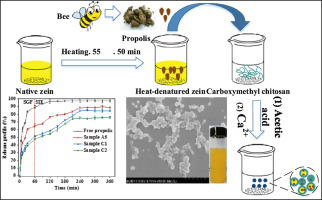当前位置:
X-MOL 学术
›
Food Hydrocoll.
›
论文详情
Our official English website, www.x-mol.net, welcomes your
feedback! (Note: you will need to create a separate account there.)
Enhanced antioxidant activity and in vitro release of propolis by acid-induced aggregation using heat-denatured zein and carboxymethyl chitosan
Food Hydrocolloids ( IF 11.0 ) Pub Date : 2018-08-01 , DOI: 10.1016/j.foodhyd.2018.02.019 Hao Zhang , Yuying Fu , Fuge Niu , Zeya Li , Chujie Ba , Bing Jin , Guowen Chen , Xiaomeng Li
Food Hydrocolloids ( IF 11.0 ) Pub Date : 2018-08-01 , DOI: 10.1016/j.foodhyd.2018.02.019 Hao Zhang , Yuying Fu , Fuge Niu , Zeya Li , Chujie Ba , Bing Jin , Guowen Chen , Xiaomeng Li

|
Abstract Propolis is a natural resinous mixture from many plant materials, buds, and exudates and is rich in polyphenols with several health beneficial properties. However, its application in food products and pharmaceuticals is hindered because of its low water solubility, undesirable sensorial characteristics and limited bio-accessibility. Here, we originally report the design and synthesis of food-grade colloidal nanoparticles as propolis carriers to enhance its oral bioavailability. Propolis was encapsulated into heat-denatured zein with carboxymethyl chitosan (CMCS) coating by acid-induced aggregation. Calcium cross-linking provided the best controlled release of propolis and improved encapsulation efficiency. The complex nanoparticles prepared under optimized conditions were spherical in shape with a Z-average diameter of ∼156 nm and zeta potential of ∼ -30 mV. Encapsulation efficiency (EE) and loading content (LC) of propolis in heat-denatured zein/CMCS nanoparticles reached∼83% and∼13.83%, respectively. Fourier transform infrared (FTIR) indicated that hydrogen bonds, electrostatic and hydrophobic interactions were the major forces responsible for nanoparticle formation. The in vitro antioxidant activity of propolis encapsulated in nanoparticles was considerably stronger than that of propolis dispersed in water. This new approach of fabricating propolis-loaded heat-denatured zein/CMCS nanoparticle provides a promising strategy with high yield and is non-toxic with improved water solubility, antioxidant activity and sustained release of propolis.
中文翻译:

使用热变性玉米蛋白和羧甲基壳聚糖通过酸诱导聚集增强蜂胶的抗氧化活性和体外释放
摘要 蜂胶是多种植物材料、芽和分泌物的天然树脂混合物,富含多酚,具有多种有益健康的特性。然而,由于其水溶性低、感官特性不佳和生物可及性有限,其在食品和药物中的应用受到阻碍。在这里,我们最初报告了食品级胶体纳米粒子作为蜂胶载体的设计和合成,以提高其口服生物利用度。通过酸诱导聚集,蜂胶被包裹在热变性玉米蛋白中,并带有羧甲基壳聚糖 (CMCS) 涂层。钙交联提供了蜂胶的最佳控制释放并提高了封装效率。在优化条件下制备的复合纳米粒子呈球形,Z 均直径为~156 nm,zeta 电位为~-30 mV。蜂胶在热变性玉米醇溶蛋白/CMCS 纳米颗粒中的包封率 (EE) 和负载量 (LC) 分别达到~83% 和~13.83%。傅里叶变换红外 (FTIR) 表明氢键、静电和疏水相互作用是导致纳米颗粒形成的主要力量。包裹在纳米颗粒中的蜂胶的体外抗氧化活性比分散在水中的蜂胶强得多。这种制造载有蜂胶的热变性玉米醇溶蛋白/CMCS 纳米颗粒的新方法提供了一种有前景的策略,产量高且无毒,具有改善的水溶性、抗氧化活性和蜂胶的持续释放。
更新日期:2018-08-01
中文翻译:

使用热变性玉米蛋白和羧甲基壳聚糖通过酸诱导聚集增强蜂胶的抗氧化活性和体外释放
摘要 蜂胶是多种植物材料、芽和分泌物的天然树脂混合物,富含多酚,具有多种有益健康的特性。然而,由于其水溶性低、感官特性不佳和生物可及性有限,其在食品和药物中的应用受到阻碍。在这里,我们最初报告了食品级胶体纳米粒子作为蜂胶载体的设计和合成,以提高其口服生物利用度。通过酸诱导聚集,蜂胶被包裹在热变性玉米蛋白中,并带有羧甲基壳聚糖 (CMCS) 涂层。钙交联提供了蜂胶的最佳控制释放并提高了封装效率。在优化条件下制备的复合纳米粒子呈球形,Z 均直径为~156 nm,zeta 电位为~-30 mV。蜂胶在热变性玉米醇溶蛋白/CMCS 纳米颗粒中的包封率 (EE) 和负载量 (LC) 分别达到~83% 和~13.83%。傅里叶变换红外 (FTIR) 表明氢键、静电和疏水相互作用是导致纳米颗粒形成的主要力量。包裹在纳米颗粒中的蜂胶的体外抗氧化活性比分散在水中的蜂胶强得多。这种制造载有蜂胶的热变性玉米醇溶蛋白/CMCS 纳米颗粒的新方法提供了一种有前景的策略,产量高且无毒,具有改善的水溶性、抗氧化活性和蜂胶的持续释放。









































 京公网安备 11010802027423号
京公网安备 11010802027423号